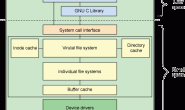目录
1. 守护进程是什么
2. 怎么用守护进程
2.1 有趣小例子
2.2 man daemon
3. 源码解析
3.1 GUN C daemon.c
3.2 daemon.c 解析
3.3 BUGS
4. 后记
1. 守护进程是什么
Linux Daemon (守护进程) 是运行在后台的一种特殊进程. 它独立于控制终端并且周期性地执行某种任务或等待处理
某些发生的事件. 不依赖用户输入就能提供某种服务.
Linux 系统中大多数服务都是通过守护进程实现的. 常见的守护进程包括系统日志进程 syslogd, Web 服务器 httpd ,
MySQL 数据库服务器 mysqld 等. 守护进程的命名我们通常约定以 d 结尾.
2. 怎么用守护进程
2.1 有趣小例子
#include <time.h> #include <stdio.h> #include <stdlib.h> #include <unistd.h> // // gcc -g -O2 -Wall -Wextra -o demo demo.c // int main(void) { // 创建守护进程 if (daemon(0, 0)) { perror("daemon error"); exit(EXIT_FAILURE); } // 守护进程 构建文本任务 FILE * txt = fopen("demo.log", "w"); if (txt) { fprintf(txt, "%ld, hello, 世界", time(NULL)); fclose(txt); } exit(EXIT_SUCCESS); }
结果出人意料呢? daemon(0, 0) ~ 通过 GNU C 库 提供的 api, 轻巧的创建了守护进程.
有心同行也可以将上面素材当做守护进程面试题, 不需要死记硬背, 简单交流下就可以考察出候选人是否严谨和用心.
2.2 man daemon
全貌了解 daemon() 函数最简单方法还是看 man daemon 手册, 摘录些一块学习学习, 温故温故.
DAEMON(3) Linux Programmer's Manual DAEMON(3) NAME daemon - run in the background SYNOPSIS #include <unistd.h> int daemon(int nochdir, int noclose); Feature Test Macro Requirements for glibc (see feature_test_macros(7)): daemon(): Since glibc 2.21: _DEFAULT_SOURCE In glibc 2.19 and 2.20: _DEFAULT_SOURCE || (_XOPEN_SOURCE && _XOPEN_SOURCE < 500) Up to and including glibc 2.19: _BSD_SOURCE || (_XOPEN_SOURCE && _XOPEN_SOURCE < 500) DESCRIPTION The daemon() function is for programs wishing to detach themselves from the controlling terminal and run in the background as system daemons. If nochdir is zero, daemon() changes the process's current working directory to the root directory ("/"); otherwise, the current working directory is left unchanged. If noclose is zero, daemon() redirects standard input, standard output and standard error to /dev/null; otherwise, no changes are made to these file descriptors. RETURN VALUE (This function forks, and if the fork(2) succeeds, the parent calls _exit(2), so that further errors are seen by the child only.) On suc‐ cess daemon() returns zero. If an error occurs, daemon() returns -1 and sets errno to any of the errors specified for the fork(2) and set‐ sid(2). ATTRIBUTES For an explanation of the terms used in this section, see attributes(7). ┌──────────┬───────────────┬─────────┐ │Interface │ Attribute │ Value │ ├──────────┼───────────────┼─────────┤ │daemon() │ Thread safety │ MT-Safe │ └──────────┴───────────────┴─────────┘ CONFORMING TO Not in POSIX.1. A similar function appears on the BSDs. The daemon() function first appeared in 4.4BSD. NOTES The glibc implementation can also return -1 when /dev/null exists but is not a character device with the expected major and minor numbers. In this case, errno need not be set. BUGS The GNU C library implementation of this function was taken from BSD, and does not employ the double-fork technique (i.e., fork(2), set‐ sid(2), fork(2)) that is necessary to ensure that the resulting daemon process is not a session leader. Instead, the resulting daemon is a session leader. On systems that follow System V semantics (e.g., Linux), this means that if the daemon opens a terminal that is not already a controlling terminal for another session, then that terminal will inadvertently become the controlling terminal for the daemon. SEE ALSO fork(2), setsid(2), daemon(7), logrotate(8) COLOPHON This page is part of release 4.15 of the Linux man-pages project. A description of the project, information about reporting bugs, and the latest version of this page, can be found at https://www.kernel.org/doc/man-pages/. GNU 2017-11-26 DAEMON(3)
翻译其中核心的几小段, 有更好翻译可以提供或者告知, 文章会迅速修正.
NAME daemon - 运行在后台 SYNOPSIS #include <unistd.h> int daemon(int nochdir, int noclose); DESCRIPTION daemon() 函数希望运行程序脱离控制终端, 作为系统守护进程在后台运行. 如果 nochdir 是 0, daemon() 将更改当前进程工作目录到 "/" 根目录. 否则保持 不变. 如果 noclose 是 0, deamon() 将重定向 STDIN_FILENO 标准输入, STDOUT_FILENO 标准输出, STDERR_FILENO 标准错误 到 /dev/null, 否则保持不变. RETURN VALUE 函数内部会执行 fork, 如果 fork 成功, 父进程会调用 _exit 退出. 执行成功返回 0. 发生错误时候将返回 -1, errno 的设置依赖 fork(), setsid(), daemon() 源码.
3. 源码解析
3.1 GUN C daemon.c
glibc-2.33/misc/daemon.c
1 /*- 2 * Copyright (c) 1990, 1993 3 * The Regents of the University of California. All rights reserved. 4 * 5 * Redistribution and use in source and binary forms, with or without 6 * modification, are permitted provided that the following conditions 7 * are met: 8 * 1. Redistributions of source code must retain the above copyright 9 * notice, this list of conditions and the following disclaimer. 10 * 2. Redistributions in binary form must reproduce the above copyright 11 * notice, this list of conditions and the following disclaimer in the 12 * documentation and/or other materials provided with the distribution. 13 * 4. Neither the name of the University nor the names of its contributors 14 * may be used to endorse or promote products derived from this software 15 * without specific prior written permission. 16 * 17 * THIS SOFTWARE IS PROVIDED BY THE REGENTS AND CONTRIBUTORS ``AS IS'' AND 18 * ANY EXPRESS OR IMPLIED WARRANTIES, INCLUDING, BUT NOT LIMITED TO, THE 19 * IMPLIED WARRANTIES OF MERCHANTABILITY AND FITNESS FOR A PARTICULAR PURPOSE 20 * ARE DISCLAIMED. IN NO EVENT SHALL THE REGENTS OR CONTRIBUTORS BE LIABLE 21 * FOR ANY DIRECT, INDIRECT, INCIDENTAL, SPECIAL, EXEMPLARY, OR CONSEQUENTIAL 22 * DAMAGES (INCLUDING, BUT NOT LIMITED TO, PROCUREMENT OF SUBSTITUTE GOODS 23 * OR SERVICES; LOSS OF USE, DATA, OR PROFITS; OR BUSINESS INTERRUPTION) 24 * HOWEVER CAUSED AND ON ANY THEORY OF LIABILITY, WHETHER IN CONTRACT, STRICT 25 * LIABILITY, OR TORT (INCLUDING NEGLIGENCE OR OTHERWISE) ARISING IN ANY WAY 26 * OUT OF THE USE OF THIS SOFTWARE, EVEN IF ADVISED OF THE POSSIBILITY OF 27 * SUCH DAMAGE. 28 */ 29 30 #if defined(LIBC_SCCS) && !defined(lint) 31 static char sccsid[] = "@(#)daemon.c 8.1 (Berkeley) 6/4/93"; 32 #endif /* LIBC_SCCS and not lint */ 33 34 #include <errno.h> 35 #include <fcntl.h> 36 #include <paths.h> 37 #include <unistd.h> 38 #include <sys/stat.h> 39 40 #include <device-nrs.h> 41 #include <not-cancel.h> 42 43 int 44 daemon (int nochdir, int noclose) 45 { 46 int fd; 47 48 switch (__fork()) { 49 case -1: 50 return (-1); 51 case 0: 52 break; 53 default: 54 _exit(0); 55 } 56 57 if (__setsid() == -1) 58 return (-1); 59 60 if (!nochdir) 61 (void)__chdir("/"); 62 63 if (!noclose) { 64 struct stat64 st; 65 66 if ((fd = __open_nocancel(_PATH_DEVNULL, O_RDWR, 0)) != -1 67 && (__builtin_expect (__fstat64 (fd, &st), 0) 68 == 0)) { 69 if (__builtin_expect (S_ISCHR (st.st_mode), 1) != 0 70 #if defined DEV_NULL_MAJOR && defined DEV_NULL_MINOR 71 && (st.st_rdev 72 == makedev (DEV_NULL_MAJOR, DEV_NULL_MINOR)) 73 #endif 74 ) { 75 (void)__dup2(fd, STDIN_FILENO); 76 (void)__dup2(fd, STDOUT_FILENO); 77 (void)__dup2(fd, STDERR_FILENO); 78 if (fd > 2) 79 (void)__close (fd); 80 } else { 81 /* We must set an errno value since no 82 function call actually failed. */ 83 __close_nocancel_nostatus (fd); 84 __set_errno (ENODEV); 85 return -1; 86 } 87 } else { 88 __close_nocancel_nostatus (fd); 89 return -1; 90 } 91 } 92 return (0); 93 }
3.2 daemon.c 解析
30-32 行 SCCS ID (SCCS 代表源代码控制系统)
66 行 和 88 行 类似 open 和 close
// sysdeps/generic/not-cancel.h /* By default we have none. Map the name to the normal functions. */ #define __open_nocancel(...) \ __open (__VA_ARGS__) #define __close_nocancel(fd) \ __close (fd)
不过 88 行不够严禁, 因为当 fd == -1 时候, 会 __close_nocancel_nostatus (-1) 会引发一个 @errno{EBADF, 9, Bad file descriptor}.
67 – 73 行 (__builtin_expect (EXP, N) 表达意思是告诉编译器预测 EXP 表试式 == 常量 N 概率很大, 返回值是 EXP ) 大致
意思获取文件属性, 并且不是字节设备. makedev 用于构建设备 id.
75-77 三行, 将 STDIN_FILENO, STDOUT_FILENO, STDERR_FILENO 句柄指向 fd 句柄所指向的 dev/null 文件.
78-79 行, 很漂亮很严谨功力很厚.
3.3 BUGS
在 2.2 中有这段话,
BUGS The GNU C library implementation of this function was taken from BSD, and does not employ the double-fork technique (i.e., fork(2), set‐ sid(2), fork(2)) that is necessary to ensure that the resulting daemon process is not a session leader. Instead, the resulting daemon is a session leader. On systems that follow System V semantics (e.g., Linux), this means that if the daemon opens a terminal that is not already a controlling terminal for another session, then that terminal will inadvertently become the controlling terminal for the daemon. BUGS GNUC 库 这个 daemon() 函数的实现取自 BSD 源码. 没有采用两次 double fork 设置 sid 机制, 来确保生成的守护进程不是会话负责人. 相反, 这里生成的守护 进程是会话负责人 (session leader). 在遵循 System V 语义系统上, 创建的守 护进程在重新打开终端时候, 新开终端会自动成为守护进程的控制终端.
参照这些内容我们补充一个大致符合 System V 版本 daemon
#include <stdio.h> #include <stdlib.h> #include <errno.h> #include <fcntl.h> #include <paths.h> #include <sys/types.h> #include <sys/stat.h> #include <unistd.h> #define INT_MAX_CLOSE (8192) /* * 创建守护进程 */ void daemon_service(void) { // fork 后父进程 exit 退出, 保证子进程可以成功 setsid() 拥有一个新会话 switch (fork()) { case -1: exit(EXIT_FAILURE); case 0: break; default: exit(EXIT_SUCCESS); } // 子进程创建新会话 // 执行成功后 Process ID(PID) == Process Group ID(PGID) == Session ID(SID) if (setsid() == -1) exit(EXIT_FAILURE); // 二次 fork 后孙进程不再是会话组首进程, 因而孙进程无法重新打开一个新的控制终端 // 执行成功后 Process ID(PID) != Process Group ID(PGID) == Session ID(SID) switch (fork()) { case -1: exit(EXIT_FAILURE); case 0: break; default: exit(EXIT_SUCCESS); } // 子进程设置新的工作目录是 根目录 "/", 避免存在挂载磁盘一直被占用的情况 if (chdir("/")) {} // 子进程重置 创建文件 权限 umask(0); // 相关句柄善后, 节省资源 fflush(stderr); fflush(stdout); int fd = sysconf(_SC_OPEN_MAX); if (fd == -1) fd = INT_MAX_CLOSE; while (fd >= 0) close(fd--); // 软处理 STDIN_FILENO, STDOUT_FILENO, STDERR_FILENO 让相关系统 api 正常使用 fd = open(_PATH_DEVNULL, O_RDWR); // fd should be 0 if (fd == STDIN_FILENO) { dup2(STDIN_FILENO, STDOUT_FILENO); dup2(STDIN_FILENO, STDERR_FILENO); } }
4. 后记
欢迎交流指正 ~
感恩 不忘初心, 与善者同行




